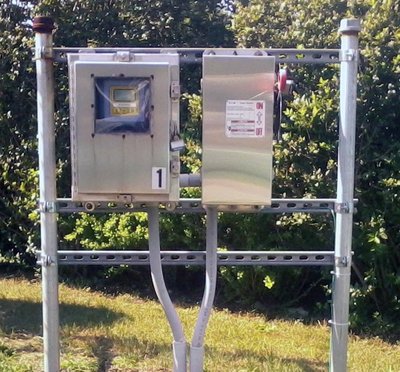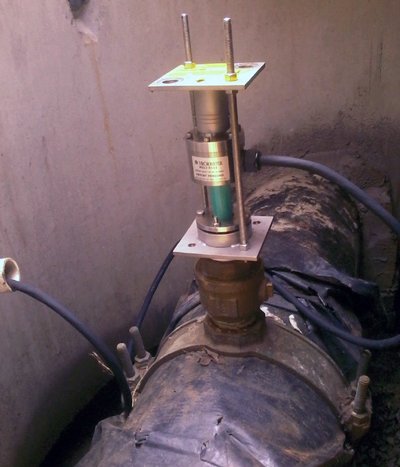Full-profile insertion mag meter improves city water management
By Jerry Stultz, Applications Engineer, and Curt Worlund, Vertical Marketing Manager, McCrometer, Inc
Tuesday, 21 May, 2013
The City of Geneva, Ohio, resides in Ashtabula County, east of Cleveland, along Lake Erie. Founded in 1816, this picturesque city is now home to 7000 residents. The City of Geneva Water Works Department is responsible for managing the city’s 1.3 megalitre per day drinking water operation.
The City of Geneva’s water distribution system has a unique history and structure. Ashtabula County bought its water system from a private utility in 2003, which includes booster stations and storage facilities, but no treatment plants. The county purchases finished water from the private utility’s treatment plant. The City of Geneva bought its water system in 2004, which is a distribution network connected within the county system. This system had no bulk metering to measure the city’s actual consumption. The city has been billed by Ashtabula County according to an agreed formula that apportions an amount of the overall county consumption to the city.
Geneva’s Water Works Department determined that in order to begin its own metering system, eight individual metering locations were needed around the city. The city management had several primary considerations when selecting a metering solution. Firstly, as a smaller municipality, Geneva has a limited budget. Securing the operational efficiency gains would depend on finding a very cost-effective solution. Since most of the city’s water mains are in the road or right-of-way, an installation solution that could support the weight of vehicles was required since rerouting pipelines away from traffic was financially infeasible.
Geneva also needed flow meters that could be installed without the need for a line shutdown, since each of the metering sites is a connection to a county distribution artery that serves both the city and county consumers on the opposite side of the city.
Thirdly, to meet Geneva’s cost-savings goal, a minimum of 1% accuracy was required and a bidirectional metering capability was necessary because the open nature of the distribution system allowed for water to flow in either direction in the pipelines.
Also, since the city’s distribution system had no bulk water metering, the nominal flow rates within the pipes were unknown.
Finally, as a scenic, residential community, Geneva had to find locations for above-ground meter reading stations that were close to primary electrical service but would not compromise the aesthetic appeal of its properties.

The Water Works Department reviewed a number of technology options, ultimately deciding that an electromagnetic flow meter would provide the accuracy and reliability needed. Different electromagnetic technologies were considered. They concluded the McCrometer FPI Mag was the only solution that addressed all their unique challenges.
Spool-type electromagnetic meters would require large vaults that would have to be installed away from traffic because these vaults could not support vehicle loading. The FPI Mag flow meter’s compact insertion design allowed Geneva to use small manholes with metal covers designed to support the load of residential traffic.
The FPI Mag insertion design also meant that installation could occur without interrupting service, dewatering lines, cutting pipe or welding flanges. Geneva spent approximately five days installing each of the eight meters in lines ranging from 6″ to 16″. This included four days to install the manholes and also electrical service to the new above-ground meter reading stations. Installation of the FPI Mag full profile sensor and electronic converter only took a combined half day, including the pulling of wiring from the sensor to the converter at the meter reading station.

Accuracy requirements were met with FPI Mag due to the FPI Mag flow meter having multiple electrodes across the entire pipe diameter. Full flow profile measurement enables a very accurate, average flow rate calculation of ±0.5% of reading in the 0.3 to 1 m/s velocity range. Additionally, the availability of the bidirectional model also fit the city’s needs, allowing it to account for water regardless of the flow direction in its distribution system.
Due to the absence of bulk metering, McCrometer used its NIST-certified, full flow test facility to calibrate the units to a reasonable maximum flow velocity for each pipe size down to a minimum velocity reflecting very low flows. Once the meters were installed, Geneva and McCrometer worked together to confirm the calibration in the field using hydrant flows and individual consumer readings collected over a span of time.
Lastly, with the FPI Mag meters requiring such little installation space, Geneva gained multiple siting options that were aesthetically satisfying.
The Geneva Water Works Department concluded McCrometer’s FPI Mag full-profile insertion flow meters met their accuracy, reliability and bidirectional requirements with an installation approach that satisfied their cost and siting requirements, as well as their need for uninterrupted operation. All eight McCrometer FPI Mag flow meters were installed in aesthetically pleasing locations, in minimal time, with minimum investment and with no operational interruptions. They are all currently performing successfully and Geneva anticipates operational cost savings of 8-12% per year as a direct result of their investment in the McCrometer FPI Mag flow metering system.
As David Corbin, McCrometer Product Manager, said, “The application for the City of Geneva benefited from several differentiators that the FPI Mag delivers. Any one of these benefits - lower total installed cost, ease of installation or accuracy - can separate the FPI Mag from other meter options, but in the case of Geneva, they were able to realise several of these benefits all at once.”
Thermal mass flowmeters: when is pressure compensation important?
The claim that thermal mass flowmetering is independent of pressure is only half of the truth.
Automating water management for improved mining sustainability
Water is fast becoming a precious commodity, and mine water management has shifted from an...
Ultrasonic and radar level technologies: bringing clarity to the water and wastewater industry
There is room for both ultrasonic and radar level measurement technologies in the water and...








